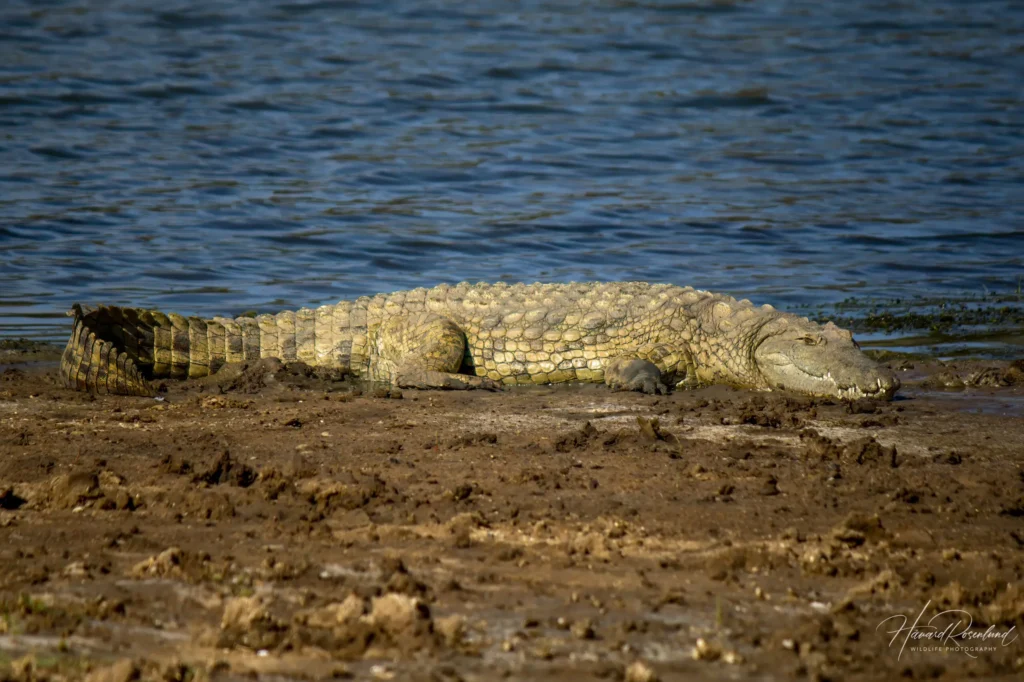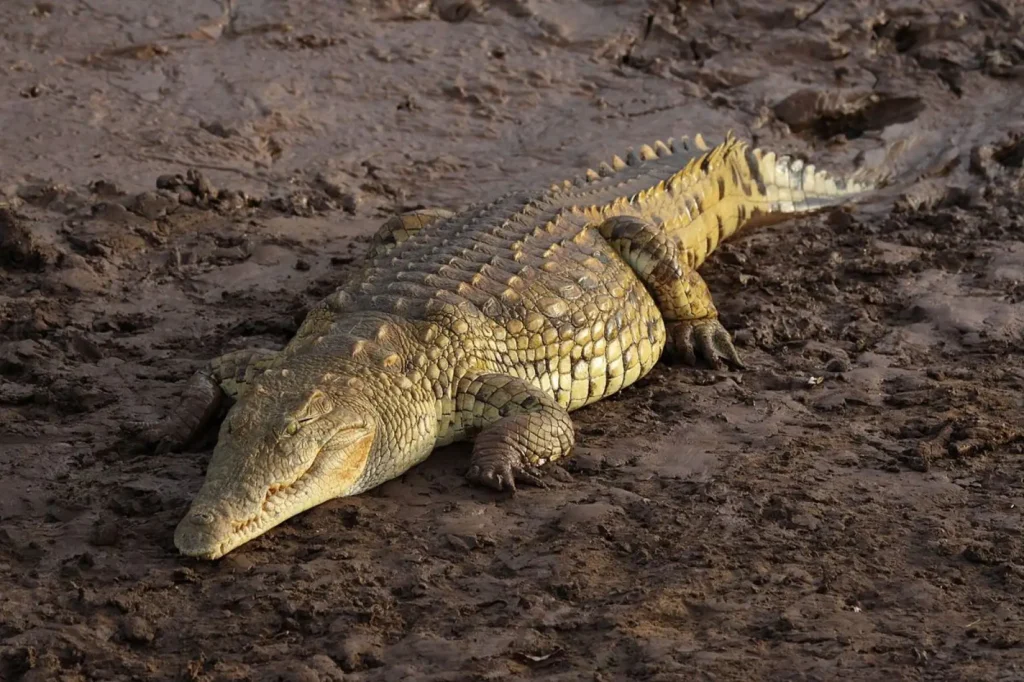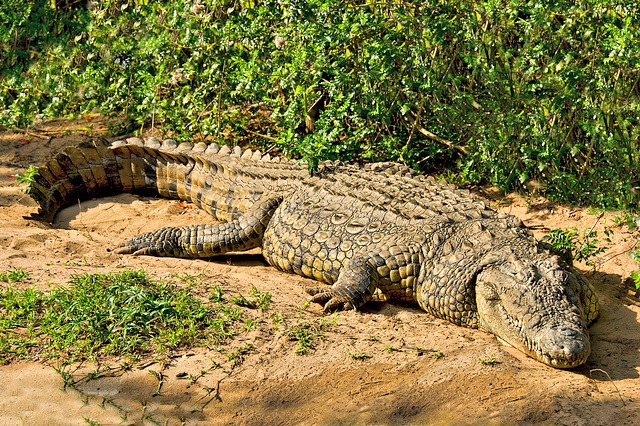Nile Crocodile Habitat Protection Efforts
Nile Crocodile Habitat Protection Efforts The Nile crocodile (Crocodylus niloticus), one of the most iconic and feared reptiles in Africa, is not only vital to the ecosystems it inhabits but is also facing increasing threats to its survival. Despite its reputation as a resilient predator, the Nile crocodile’s natural habitat is under constant pressure from human activity, climate change, and environmental degradation. Protecting these habitats is critical not just for the crocodile, but for the entire ecological balance of the regions it inhabits.
Current Habitat of Nile Crocodiles

Nile crocodiles are primarily found in freshwater environments such as rivers, lakes, marshlands, and swamps across sub-Saharan Africa, the Nile Basin, and Madagascar. Their habitat ranges from large river systems like the Nile to small, remote lakes and wetlands. These reptiles are highly adaptable, thriving in varied environments that provide adequate food and breeding grounds. Key countries where Nile crocodiles can be found include Egypt, Sudan, Kenya, Tanzania, South Africa, and Mozambique, among others.
Here’s a table summarizing the key aspects of Nile crocodile habitat protection efforts:
| Category | Details |
|---|---|
| Nile Crocodile Habitat | Rivers, lakes, marshlands, wetlands across sub-Saharan Africa and the Nile Basin |
| Threats to Habitat | – Human encroachment (agriculture, urbanization) |
| – Pollution (industrial/agricultural runoff) | |
| – Climate change (droughts, altered rainfall) | |
| – Illegal hunting (poaching) | |
| – Infrastructure projects (dams, waterway diversion) | |
| Conservation Efforts | – Protected areas (national parks, wildlife reserves) |
| – Wetland restoration and river rehabilitation | |
| – Anti-poaching laws and patrols | |
| – Sustainable tourism practices | |
| – International conservation collaborations | |
| Community Involvement | – Education and awareness programs |
| – Local community participation in conservation | |
| – Sustainable livelihoods (eco-tourism, wildlife management) | |
| Success Stories | – Selous Game Reserve (Tanzania) |
| – Kruger National Park (South Africa) | |
| – WWF-led wetland restoration projects in Kenya and Uganda | |
| Challenges | – Political and economic barriers |
| – Lack of funding | |
| – Human-crocodile conflict | |
| Future Prospects | – Technological advancements in habitat monitoring |
| – Policy reforms and international laws | |
| – Scientific research on crocodile ecology |
This table highlights the key points related to Nile crocodile habitat protection efforts, including threats, conservation actions, community roles, and future prospects.
The diversity of habitats they occupy reflects their adaptability, but also highlights the fragility of these ecosystems. Freshwater ecosystems, in particular, are vulnerable to human interference and environmental change.
Threats to Nile Crocodile Habitats
Despite their adaptability, Nile crocodile populations are increasingly threatened by various human-induced factors:
- Human encroachment: As agriculture, urbanization, and tourism expand, more and more crocodile habitats are being encroached upon or destroyed. Wetlands and riverbanks are converted into farmlands or construction sites, leaving crocodiles with less space to live and breed.
- Pollution: Industrial and agricultural runoff pollutes the waterways where Nile crocodiles live. Water contamination affects the health of both the crocodiles and their prey, reducing food sources and causing diseases.
- Climate change: Rising temperatures and changing rainfall patterns lead to droughts and water shortages, affecting wetlands and river systems. As water levels fluctuate, so do the conditions necessary for crocodiles to thrive. Prolonged droughts can dry up important nesting sites and food sources.
- Illegal hunting: Despite international and national laws, illegal poaching of Nile crocodiles for their skins and meat remains a persistent threat. Habitat degradation exacerbates this by making poaching easier in areas where crocodile populations are already vulnerable.
- Infrastructure projects: The construction of dams and waterway diversions has altered natural river systems, disrupting the flow of water and the availability of essential resources in crocodile habitats.
Conservation Efforts for Nile Crocodile Habitats

Various conservation efforts have been implemented to protect Nile crocodile habitats, with a focus on safeguarding and restoring these crucial ecosystems:
- Protected areas: Many Nile crocodile populations are now found in national parks, wildlife reserves, and protected wetlands. These areas provide a safe haven for crocodiles, with less interference from human activities.
- Restoration projects: Conservation groups are working to rehabilitate degraded wetlands and river systems. Restoring natural water flows and replanting vegetation can create more stable environments for crocodiles to breed and hunt.
- Anti-poaching measures: Stronger laws and enforcement actions have been put in place in many countries to combat illegal crocodile hunting. Anti-poaching patrols, surveillance, and community outreach programs help deter poachers and protect these endangered reptiles.
- Sustainable tourism practices: Some regions have embraced eco-tourism, which allows tourists to witness Nile crocodiles in their natural habitats without disturbing the ecosystem. Well-managed wildlife tourism provides an economic incentive for local communities to protect habitats rather than exploit them.
- International collaborations: Cross-border conservation initiatives have been developed to protect Nile crocodile populations across different countries. International conservation bodies such as the World Wildlife Fund (WWF) and the International Union for Conservation of Nature (IUCN) are key players in supporting these efforts.
Community Involvement in Habitat Protection

Effective conservation often involves the support and participation of local communities. Educating and engaging these communities in habitat protection is a critical part of conservation strategies:
- Education and awareness campaigns: Many organizations run awareness programs highlighting the importance of Nile crocodiles and their role in maintaining healthy ecosystems. Understanding the role crocodiles play in controlling fish populations and preserving the balance of freshwater systems fosters appreciation among local populations.
- Local community participation: Conservation projects often involve local communities in activities such as habitat restoration and monitoring. Encouraging locals to become stewards of their environment not only helps conservation efforts but also provides economic benefits.
- Economic alternatives: Sustainable livelihoods such as eco-tourism, wildlife management, and conservation-related jobs provide locals with alternatives to activities that damage crocodile habitats, such as farming on wetlands or hunting crocodiles.
Success Stories and Case Studies
There have been several success stories in Nile crocodile habitat protection:
- In Tanzania, the Selous Game Reserve has become a major stronghold for Nile crocodiles, thanks to its expansive wetland ecosystems and robust anti-poaching measures.
- South Africa’s Kruger National Park is another success story where conservation efforts have resulted in a stable crocodile population. Strict laws and sustainable tourism have contributed to the park’s effective management of habitats.
- International conservation organizations, including WWF, are actively involved in cross-border projects aimed at restoring wetlands and protecting crocodiles in countries like Kenya and Uganda.
Challenges in Conservation Efforts
Despite these successes, many challenges remain:
- Political and economic barriers: In many regions, political instability, corruption, and limited resources hinder the enforcement of conservation laws.
- Funding shortages: Habitat protection is expensive, and many countries struggle to allocate sufficient funds for conservation efforts.
- Human-wildlife conflict: As human populations grow and expand into crocodile habitats, conflicts between humans and crocodiles increase, sometimes resulting in the killing of crocodiles perceived as threats.
Future Prospects for Nile Crocodile Habitat Protection

The future of Nile crocodile habitat protection depends on innovation and continued collaboration:
- Technological advancements: Advances in satellite monitoring, drones, and data analysis are enabling more effective monitoring of crocodile populations and habitats.
- Policy changes: Stronger international and national laws will be crucial in protecting critical habitats and reducing threats like poaching and habitat encroachment.
- Scientific research: Ongoing research into crocodile behavior, ecology, and environmental needs will inform better conservation strategies, ensuring habitats are protected in the long term.
Conclusion
The protection of Nile crocodile habitats is a multifaceted challenge that requires concerted efforts from governments, organizations, and local communities. With the right conservation strategies, these ancient reptiles can continue to thrive in the ecosystems they have dominated for millions of years. Protecting their habitats not only ensures the survival of the Nile crocodile but also supports the broader health of Africa’s freshwater ecosystems.
Here are some practical tips for promoting Nile crocodile habitat protection efforts:
Tips for Promoting Nile Crocodile Habitat Protection
Raise Awareness:
- Educate yourself and others about the importance of Nile crocodiles in maintaining ecosystem balance.
- Share information through social media, blogs, and community events to spread awareness.
Support Conservation Organizations:
- Donate to or volunteer with organizations that focus on crocodile conservation and habitat protection.
- Participate in local conservation projects or programs to contribute directly to habitat restoration.
Practice Responsible Tourism:
- Choose eco-friendly tourism options that prioritize wildlife conservation and minimal environmental impact.
- Follow guidelines set by tour operators regarding wildlife observation, ensuring that crocodiles and their habitats are not disturbed.
Reduce Pollution:
- Avoid using harmful chemicals and pesticides in gardens or when cleaning around water bodies.
- Participate in local clean-up efforts to remove litter and pollutants from rivers and wetlands.
Advocate for Sustainable Practices:
- Support policies and practices that promote sustainable land use and protect natural habitats from development.
- Encourage local businesses to adopt sustainable practices that minimize habitat destruction.
Engage with Local Communities:
- Involve local communities in conservation efforts by promoting sustainable livelihood options.
- Listen to the needs and concerns of communities living near crocodile habitats to ensure effective conservation strategies.
Report Illegal Activities:
- Stay vigilant for illegal poaching or habitat destruction and report such activities to the appropriate authorities.
- Support anti-poaching initiatives by participating in community patrols or educational programs.
Promote Research and Education:
- Advocate for funding and resources to support scientific research on Nile crocodile populations and their habitats.
- Encourage educational programs in schools that teach students about local wildlife and conservation efforts.
Support Habitat Restoration Projects:
- Participate in or contribute to restoration initiatives that aim to rehabilitate degraded wetlands and rivers.
- Plant native vegetation along riverbanks and wetlands to improve habitat quality and stability.
Stay Informed:
- Keep up with news and developments related to crocodile conservation efforts and habitat protection.
- Engage with online forums or groups dedicated to wildlife conservation to share ideas and strategies.
By implementing these tips, individuals can contribute to the protection and preservation of Nile crocodile habitats, ensuring that these remarkable reptiles continue to thrive in their natural environments.
Here are some frequently asked questions (FAQs) related to Nile crocodile habitat protection efforts:
FAQs: Nile Crocodile Habitat Protection
Why is protecting Nile crocodile habitats important?
- Protecting Nile crocodile habitats is crucial because these reptiles play a vital role in maintaining the health of freshwater ecosystems. They help control fish populations and contribute to nutrient cycling, which supports overall biodiversity.
What are the main threats to Nile crocodile habitats?
- The primary threats include human encroachment (such as agriculture and urbanization), pollution (from industrial and agricultural runoff), climate change, illegal hunting, and infrastructure projects like dams and waterway diversions.
How can local communities get involved in conservation efforts?
- Local communities can participate by engaging in habitat restoration projects, adopting sustainable farming practices, attending educational programs, and becoming stewards of their environment through wildlife monitoring and reporting illegal activities.
What role does tourism play in protecting crocodile habitats?
- Responsible eco-tourism can provide financial incentives for local communities to protect wildlife and their habitats. Sustainable tourism practices help reduce habitat disturbance and raise awareness about the importance of conservation.
Are Nile crocodiles endangered?
- While Nile crocodiles are not currently classified as endangered, certain populations are threatened due to habitat loss and poaching. Conservation efforts aim to stabilize and increase their populations in the wild.
How can individuals contribute to habitat protection?
- Individuals can contribute by supporting conservation organizations, practicing responsible tourism, reducing pollution, advocating for sustainable land use, and participating in community clean-up efforts.
What are some successful conservation projects for Nile crocodiles?
- Successful projects include the establishment of protected areas, wetland restoration initiatives, and anti-poaching patrols in places like Tanzania’s Selous Game Reserve and South Africa’s Kruger National Park.
How does climate change affect Nile crocodile habitats?
- Climate change leads to altered rainfall patterns, increased temperatures, and more frequent droughts, all of which can impact the availability and quality of freshwater habitats essential for crocodile survival.
What can be done to combat illegal poaching of Nile crocodiles?
- Combating illegal poaching involves strengthening laws and enforcement measures, conducting anti-poaching patrols, raising awareness in local communities about the importance of crocodiles, and providing economic alternatives to poaching.
Where can I learn more about Nile crocodile conservation?
- You can learn more by visiting websites of conservation organizations such as the World Wildlife Fund (WWF), the International Union for Conservation of Nature (IUCN), and local wildlife agencies. Participating in workshops, seminars, or educational programs can also enhance your knowledge.